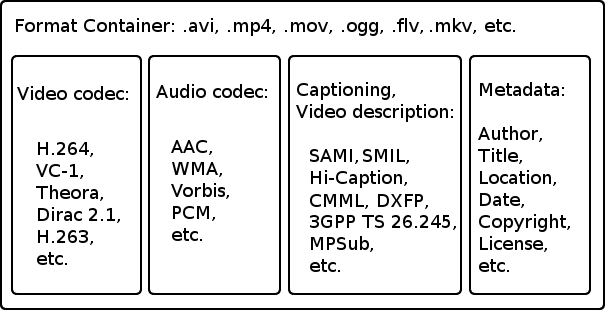Description
This article describes the different components involved in a video upload. As well, it will explain how different language streams can be added to a single video file.
What is a container?
The video file that will be uploaded is actually a container comprising a number of components:
- Video codec
- Audio codec
- Captioning or video description
- Metadata
Here, codecs refer to a set of algorithms used to compress video or audio streams.
Please consult this article for video and audio codecs that we support.
As indicated by the diagram above, containers also contain different media types, such as video and audio, as well as captions and metadata about the file.
Therefore, the term "file format" refers to the container format, after which the file extension for normal video files is named. Some file extensions include .avi, .mp4, .mkv.
Video files (containers) with streams
The videos you will upload will contain one video and audio track, which are known as "streams".
You can have a video file with multiple audio streams or a video file with captions in different languages (subtitles) or video descriptions (closed captioning for accessibility purposes).
Create a video file with multiple audio streams or subtitles
If you want to upload
- a video with multiple audio streams, the video file must contain multiple supported audio codecs.
- a video with multiple subtitles or video descriptions for accessibility purposes, the video file must contain multiple supported text or subtitle file formats (a list is found here).
- a video with both multiple audio streams AND multiple subtitles or video descriptions, the video file must contain both the supported audio codecs AND supported text formats.
Consult your video editing software manual or tutorial for information on multiple audio codecs and subtitles or video descriptions.
Language codes supported
We support languages and language codes that follow the ISO 639-2 standard. A complete list can be found here.
